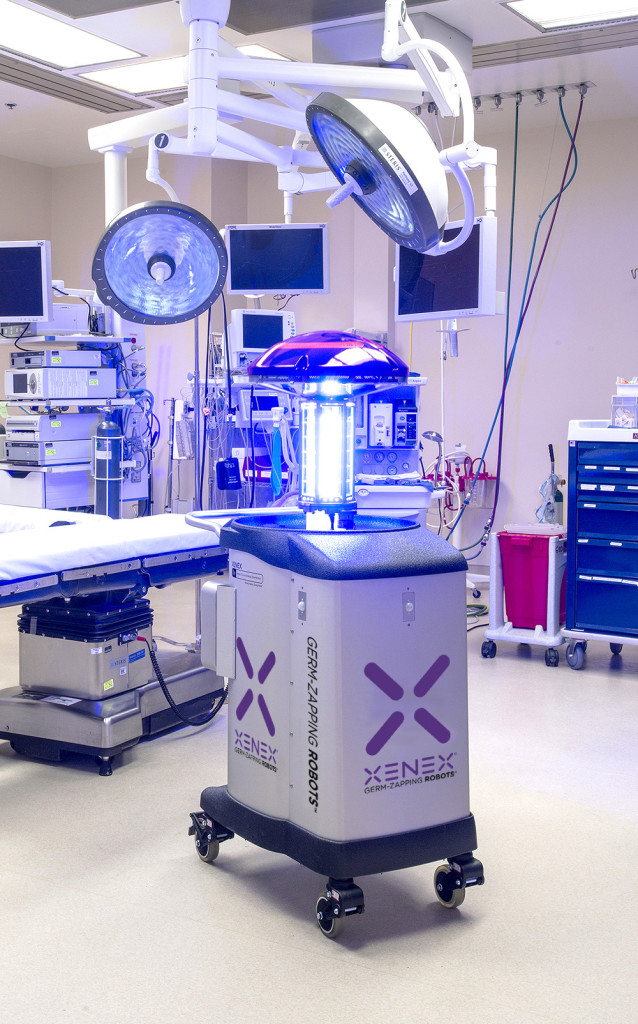As the world scrambles to contain the deadly Ebola outbreak, which has infected up to 9,900 people and claimed nearly 4,900 lives, some hospitals have turned to robots to help them fight back.
Xenex Disinfection Services, a Texas-based company founded by two epidemiologists, has developed a line of robots to help eliminate pathogens that cause infections. The company’s CEO, Morris Miller, offered more insight into the Xenex technology in an email interview with TECHtonics.
Q. What do your robots do exactly?
Miller: … Xenex robots are scientifically proven to be effective against the most dangerous pathogens, including Clostridium difficile (C. diff), Ebola virus, norovirus, influenza, and staph bacteria, including Methicillin-resistant Staphylococcus aureus, better known as MRSA.
… The Xenex germ-zapping robot works by pulsing xenon, an inert gas, twice a second at high intensity in a xenon ultraviolet flashlamp. This produces ultraviolet C (UVC), which penetrates the cell walls of microorganisms including bacteria, viruses, mold, fungus and spores. Their DNA is instantly fused so that they are unable to reproduce or mutate, effectively killing them on surfaces and in the air without contact or chemicals.
Q. Is the technology harmful in any way?
Miller: No … Xenex robots are considerably faster, safer and “greener” than other automated cleaning and infection control methods, including toxic mercury UV and hydrogen peroxide-based systems, which can take multiple hours to achieve the same level of disinfection.
Q. Have the machines been field-tested?

A Xenex germ-zapping robot can disinfect a typical patient/procedure room in 5-10 minutes. (Xenex)
Miller: The robots are in use in more than 250 U.S. hospitals. Hospitals using our robots to disinfect their facilities are reporting a drop in their infection rates (a decrease in healthcare- associated infections – HAIs), which is how we measure success. Xenex represents a significant advancement in UV disinfection technology, which has historically relied upon mercury bulbs requiring significantly greater exposure times to disinfect.
Six peer-reviewed studies have been published supporting the efficacy of the Xenex technology, including three where Xenex customers reported significantly reduced HAI rates after implementing the Xenex robot for room disinfection. No other UV technology has peer-reviewed studies demonstrating the impact of the technology on actual patient infection rates.
Q. Why are the robots not deployed in more hospitals, especially where Ebola cases have emerged?
Miller: Our robots are in use at Texas Health Presbyterian Dallas Hospital, and have been used to disinfect the areas where Ebola patients were treated.
… The Xenex robot goes in after the patient has left the area (ambulance, ER, patient room, etc.) and ensures that the environment is disinfected and safe for the next patient or healthcare worker.
Q. What was your June testimony in Congress about?
Miller: … Xenex presented testimony about the effectiveness of our germ-zapping robot in reducing healthcare-associated infection (HAI) rates at U.S. hospitals and VA facilities.
We believe strongly in the efficacy of our robots and are very proud that we are helping keeping our nation’s veterans safe. We believe Congress has an opportunity to meaningfully improve the health of its veterans and citizens by promoting policies that accelerate the adoption of technologies that can effectively disinfect the hospital environment.
Q. What do the robots cost?
Miller: The base price of a robot is $104,000 – preventing just two or three infections pays for the device. Most of our customers report ROI (return on investment) in less than four months.
Q. How do you keep track of the robots once deployed?
Miller: Each robot has an easy to use on-board database which logs system activity for utilization tracking and analysis. The robot connects wirelessly to an online customer portal for extensive reporting on utilization. Hospitals track device usage by user and by room so they can monitor which rooms have been disinfected, for example, and the number of rooms each user is doing. We analyze customer data proactively to ensure each hospital is meeting its utilization goals.
Q. What sets your robots apart from others?
Miller: Mercury bulb-generated ultraviolet light has been used for air and water disinfection for decades. There are dozens of companies now marketing mercury bulb UV light devices for surface disinfection in healthcare facilities. Mercury bulbs contain elemental mercury, which means they are classified as hazardous and toxic, and may require special handling if a bulb is damaged.
If a bulb breaks, mercury vapor is absorbed by the lungs at a 90 percent rate which is far more dangerous than a broken thermometer, which uses liquid mercury.
… Xenex … technology is 25,000 times more intense than mercury UV systems and enables Xenex’s germ-zapping robots to disinfect healthcare facilities in a fraction of the time it takes for mercury bulb devices to disinfect rooms.
Pulsed xenon emits high intensity UVC light across a broad germicidal spectrum (200-280 nanometers versus the single spectrum of 253.7 nanometers for mercury bulbs). This broad germicidal spectrum enables Xenex devices to eliminate a wider range of pathogens at a much faster rate than mercury devices.
The Xenex germ-zapping robot can disinfect a typical patient/procedure room in 5-10 minutes … The only non-mercury UV room disinfection solution is provided by Xenex.

2 responses to “Q&A: Robots Join Fight Against Ebola”
[…] […]
Thank you.